This is an attempt to show how my discoveries should alter our assessment of Rembrandt’s character and the extent of his corpus in major ways. I accept what his contemporaries said about Rembrandt, the scholars pursue their post-photography ideal of ‘invention’ as the prime quality of art. Rembrandt ‘produced’ his tableaux vivent to work from but he put his chief creative effort into observing the expression of feeling in his drawing, which of course involved memory of his life’s experience. Groups of life models cannot maintain expression for the time the artist needs to complete a drawing. He presumably posed his models with care but he then interprets their inner thoughts brilliantly relying on memories of experience.
Truly horrid things have been said about Rembrandt in the press as a result of recent scholarship. For instance in the New York Herald Tribune. “Rembrandt was a money-changer in the temple of art”, followed by a whole paragraph of hostility. In the same year 1991, when the 3 major exhibitions were taking place to establish the new scholarship he was compared more often with Andy Warhol in the press than with any other artist, for his business procedures based on the erroneous idea that he ran a huge workshop churning out his recently dismissed works, signing them and selling them as his own. In fact though such practices were normal in Rembrandt’s time, he was determined to paint every stroke himself. The experts can find no other hand but Rembrandt’s in “The Night Watch”. After that success he fell from favour in the market-place so there was no temptation to do otherwise with later works. Rembrandt ran an art school not a workshop.
The whole idea of Rembrandt’s Workshop is a recent invention, you will find no reference to it before 1968 when the RRP started work, its a fabrication. Rubens had a workshop of a few very gifted assistants because he was catering for the whole Catholic world in a post Reformation crisis. He was amazingly gifted and with an enormous market gasping for his painting. Rembrandt, a contemporary, was the other side of the coin altogether. He would have loved to be in Rubens’ position but the protestants had no use for “idols”, they were busy breaking them up. He sold more self-portraits than religious subjects but his ambition to be a history painter and his special gift for seeing how we humans express ourselves physically could not be denied. The Bible was his main source of inspiration throughout his life. But I guess when the “experts” finally revise their ideas about the dates of his drawings, fewer group subjects will be found after his peak popularity c.1642. Before that he had access to many models and many students to help pay for them.
Rembrandt himself rarely if ever painted still life or landscape though he made many beautiful drawings of the landscape around Amsterdam. Otherwise, his painted landscapes were nearly always just as a background for human subjects. On the one occasion when he was asked for a landscape he had only a student’s example in stock and he answered the request in a straightforward manner saying “with a few touches from me it could pass for a Rembrandt”. The idea that he would accept student work on his own is outrageously far fetched.
I have shown how mistaken is the designation of his reworking of his own drawing of Job and his Comforters as a student work corrected by Rembrandt, downgrades a drawing which can teach us much and correct our assessment of his character. Link
I believe in over 2000 drawings by Rembrandt. The specialists vary but have recently reduced his output drastically; for instance Otto Benesch’s catalogue of 1954 contained nearly 1500 but today’s scholars – P.Schatborn (recently of the Rijksmuseum) believes in only 500, Professor Slive emeritus of Harvard believes in c.800. How is it possible that these experts vary so widely?
The answer is very simple, the establishment experts believe that stylistic analysis is scientific. I believe that stylistic analysis is hugely mistaken. It is true that in handwriting one can recognise the person whose writing; writers are working with letters which they have used thousands of times and it doesn’t matter truly whether they are using a pencil, a ball pen or a nib the way they would form a letter will always be more or less the same. Writing music Mozart wrote semiquavers in a way that is different from Beethoven’s and recognisably different. Unfortunately with art it doesn’t work the same way. Perhaps we are always drawing hands but all hands are different, they may all have five fingers but seen from different points of view they vary enormously, also according to the age of the subject and so on. Van Dyck was famous for his hands Illust.1. they are always very aristocratic. long fingers, very elegant and always more or less the same. Probably not one in a hundred aristocrats had hands resembling these but most would have wishes for them and would pay well for receiving their attribution.
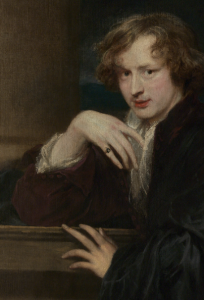
Van Dyke Hands
Rembrandt, however, is famous for the breadth and precision of his responses. His hands are incredibly different from one another; they vary not only with the age of his models but with the instruments he uses which will deposit more or less ink as he draws on papers with varying absorbencies. Naturally the marks made are different and the shapes wonderfully varied according to what he is observing at the time.(hand of plait 2), If the subject was momentary, the hands suffer.(naughty boy 3)
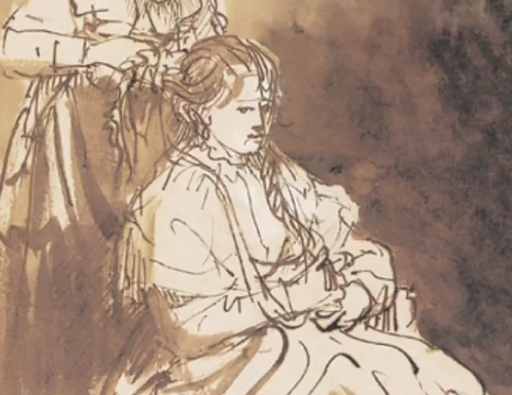
Here the hands holding the plait are Rembrandt at his very best, so specific and unique.
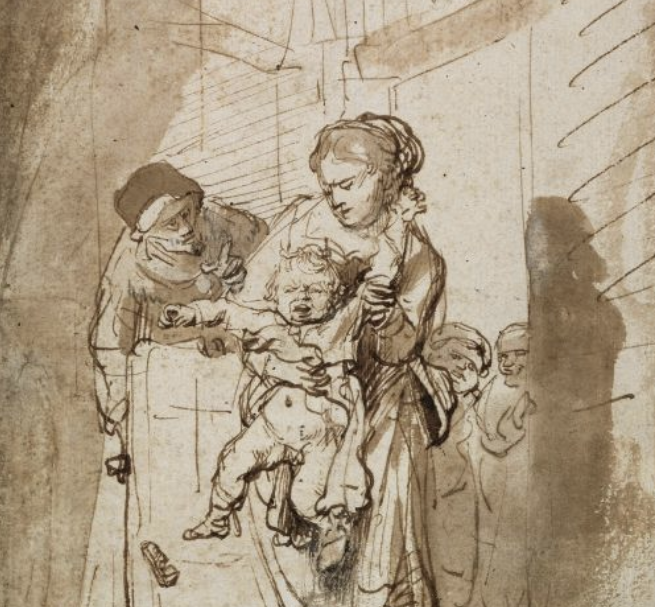
Rembrandt - naughty boy. The pose is wonderful but the hands minimal.
Artists tend to admire the variety of his responses and tend to be bored by Van Dyke’s stereotypes while still admiring their elegance. Rembrandt has suffered enormous loss in the last 50 years because the experts want Rembrandt to be consistent; he was not. His contemporaries all tell us how unreliable he was and his etchings demonstrate the truth of this. But the writer of the catalogue, Otto Benesch claims he could date a Rembrandt drawing by style to within 1 or 2 years, 3 at most. The marketplace is impressed by this boast. I am appalled; in fact I have proved beyond reasonable doubt that Benesh’s method of dating drawings is completely at odds with the facts. As the advertisement for my talk at the Wallace Collection states “Konstam’s discoveries have proved surprisingly controversial considering that they agree entirely with the documentary evidence of of Rembrandt’s own contemporaries and earlier connoisseurship. They are clear and obvious to the layman observer. It is today’s scholars that are out of step.”
I have shown how Rembrandt responds to the different stimulus he is working from. If he is working from life under his control he can take his time and sometimes draws hands unbelievably skilfully. (Hagar4).
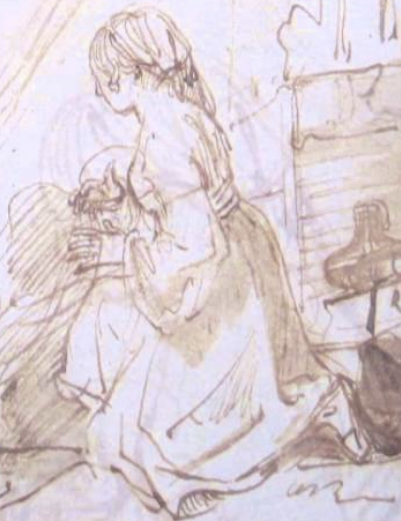
Hagar meets the Angel - beautifully drawn hands
Sometimes life in the street. The Pancake maker is not under his control so his hands become pretty wild.
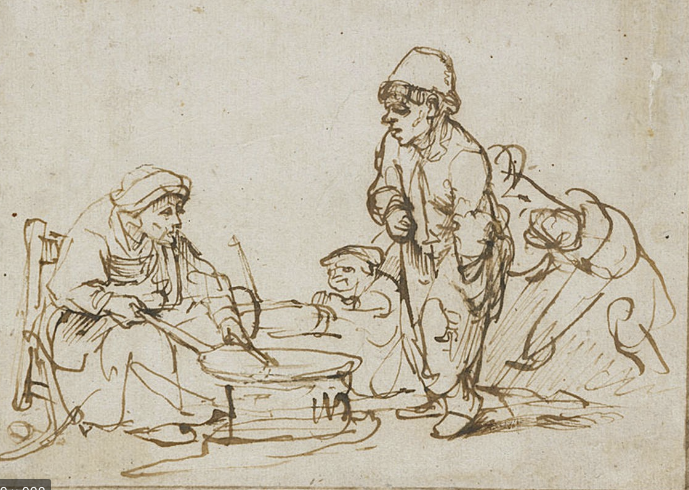
Street vendor - Pancake maker
If he’s drawing from a mirror (hand from mirror image 6)
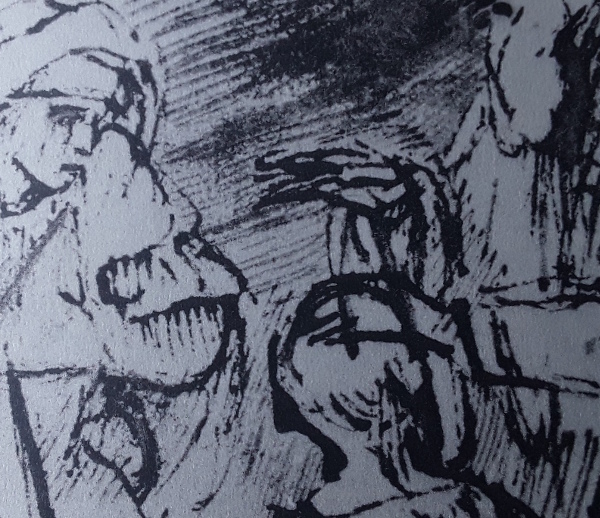
Abraham's hands observed in a mirror
which he has done at least 100 times in my estimation we can expect the result to be a great deal less interesting than when he is responding to life directly. All this is common sense, it should not surprise us. But the marketplace would like Rembrandt to be reliable, in truth the quality of his drawing is more varied than any other great artist I can think of – as demonstrated here.
The experts think he was drawing out of his head almost all the time. I know that he was drawing from life whenever possible. His contemporaries tell us “he would not attempt a single brushstroke without a living model before his eyes” that could hardly be clearer. Why have the experts decided the opposite? When he didn’t have life in front of him his imagined drawings are very different and inferior (see Jupiter with Philemon and Baucis 8 whole). The worst drawing certainly by Rembrandt because his writing on the drawing tells us the story that the drawing itself fails to convey..
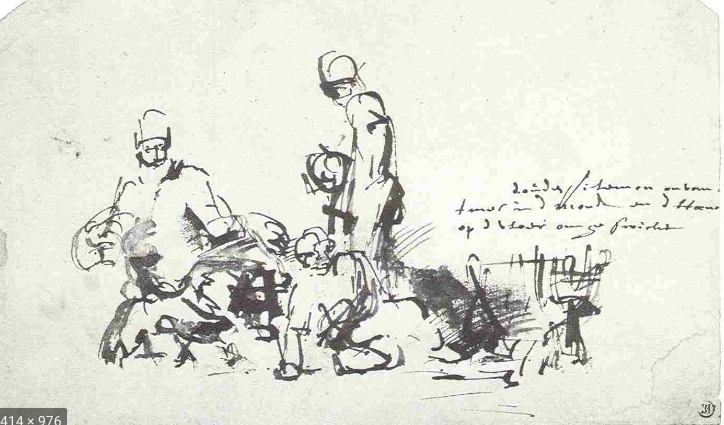
Jupiter with Philemon and Baucis
When he had life in front of him his results also varied enormously and unlike Michelangelo he didn’t seem to mind leaving behind some very inferior drawings for us to puzzle over. Rembrandt varies from exquisite to quite banal or careless as a draftsman; that is why I can believe he produced very many drawings of which over 2000 still exist today. We know he had students who drew from the same reality he set up to work from himself but fortunately none of his students drew remotely like him; some of them were reasonable draughtsman, none of them approaching greatness.The confusion is of the scholars making. The trouble is the experts recognise excellence in Florentine Renaissance art and are disappointed in Rembrandt’s genius because it is not the same. Where the Florentines were great at the nude physique Rembrandt is interested primarily in what is going on in the head/heart of his subjects. I cannot agree with Houbraken that “his female nudes were such pitiful things that they are hardly worth mentioning” but I can easily understand why he said it. I therefore question the recent de-attribution of a few mediocre drawings which are clearly of Rembrandt’s mistress Hendrijke, one of which is a preliminary study for a famous etching! The Arrow Holder.
My method of assigning drawings to Rembrandt relies on identifying his style of form making that is based on three dimensional geometry derived from Rome rather than from the Florentine method, Greece.. I don’t care if he makes a blot or a mess in his drawing of “The Deathbed of David”
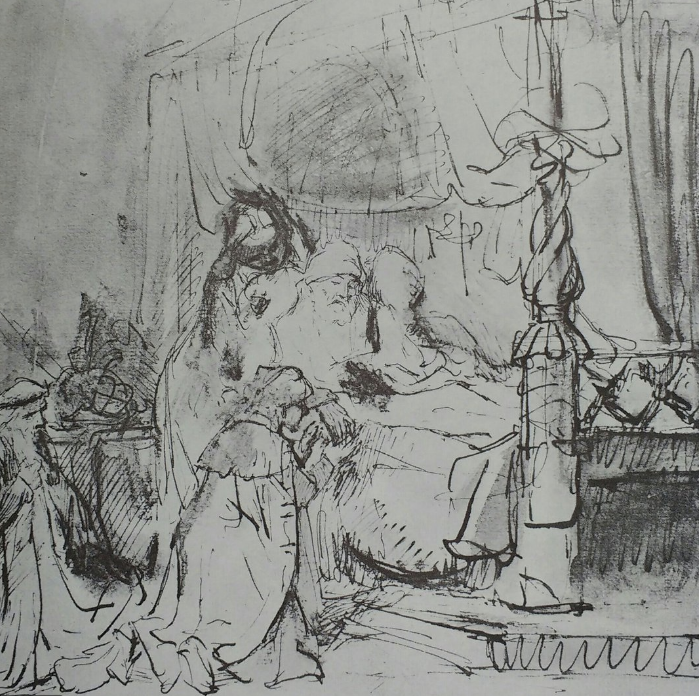
Deathbed of David
because two-thirds of the drawing is so superb as illustration and typical in form it could not possibly be by one of his students, nor for that matter by Van Dyck. Only very rarely am I in doubt as to whether a drawing is by Rembrandt or by someone else because his work, good or bad, is on a different plane all together. By accepting as justified the critical descriptions of Rembrandt’s work by his contemporaries I have no difficulty in accepting some mediocre drawings by him (see Harsh Criticisms below).. Our experts alas, see the faults but do not seem responsive to his genius. They have little understanding of his style and less of his character or enthusiasms, they regard the mention of human interest as ‘unscientific’. No wonder they have missed Rembrandt to the point of madness. It is pointless to expect Rembrandt to behave like the classical masters. He is the first of the moderns; he was living through the revolution that has created modern science, Rembrandt has changed art in a similar way- by confidence in his own observations rather than in artistic tradition.
Rembrandt spent half his creative energy on a subject matter which from a market point of view was a non-starter in protestant Holland. He painted what he wanted not what the market demanded. We don’t even know to which protestant sect he belonged. He got involved with the Calvinists because Hendrijke, his partner for 17 years, was accused by them of living with Rembrandt in concubinage. He did not show up at her trial, maybe he had become a Mennonite by then. We can surmise that he was a believer of some kind but there are good reasons for him to be involved with Biblical subjects other than belief:
The Bible was the best known book of stories of every kind, read throughout Christendom and beyond. It had recently been translated into most of the languages of Europe from Latin, Greek or Aramaic and so was hot news for most Christians. The sheer richness of the human subject matter was a gold-mine for anyone interested in investigating the human psyche. The only other possibility for the same mining was classical mythology, which he used occasionally. But it did not have the same popular following. Ovid was for the scholarly few.
Rembrandt does not compete with Rubens, Van Dyck or Hals in swiftness of execution; he goes his own way at his own pace, often remarkably slowly. The experts like him to be making bold strokes,often these are a last resort to make clear second or third thoughts.. Rembrandt was a true artist seeing life as truthfully as he could, without embellishment. He is very much a man of his own time insofar as he is following the example of the great scientists who refused to take Aristotle’s word for how the physical world works, they too observed for themselves. That is why many artists regard Rembrandt as the one old master who speaks to us moderns directly. Other old masters we can admire but there is not that feeling that we are in the same business. Rembrandt is the beginning of the modern era in art as Copernicus, Galileo and Newton are in science.
The scholars want him to be the same as the older masters; he is not. They seem to have no idea of his originality. To read recent scholars is to get no guidance as to why the rest of us admire him so much, its as if they need to pigeonhole him and in so doing, rob him of his unique position in art. They are looking with a narrow focus without understanding; they want to know which works are his without any discrimination as to which are better or worse, a distinction of most interest to the rest of us.
I offer a rational explanation for his variability – the scholars seek to explain it by the development of his style. They talk in special jargon to put their folly beyond common sense criticism. Rembrandt relied on observation more than most. He did not believe in invention and made that plain when he was obliged to invent: (flying angel).
***************
Panowski recommended art historians should not fall in love with their subject; reasonable advice but it has been followed to the annihilation of any kind of appreciation. Scholars are afraid of making judgements that will not last. Nothing lasts in man’s restless view but its necessary to make judgements to guide our own present effort. I regard Rembrandt as the most important artist ever and I am fully prepared to tell you why.
Rembrandt was following Caravaggio’s example in a general way, there were several Caravaggists in Holland at the time. In this he was merely following a trend. When he set up studio in his home town of Leyden with his younger but more experienced partner Jan Lievens, he was clearly the junior partner in quality but from those inauspicious beginnings he rose rapidly. He acquired the technical mastery of Lievens and surpassed him in vision in 2 or 3 years. His painting of “Judas Returning the 30 pieces of Silver” was noticed and praised by Huygens as better judgement and taste than Lievens. It is highly dramatic and set Rembrandt on his way towards the expression of human emotion which was to drive his art for the rest of his life. Interestingly it is the first of his paintings that we can recognise immediately as the Rembrandt we know from his subsequent output. His earlier work is quite different and amazingly inferior.
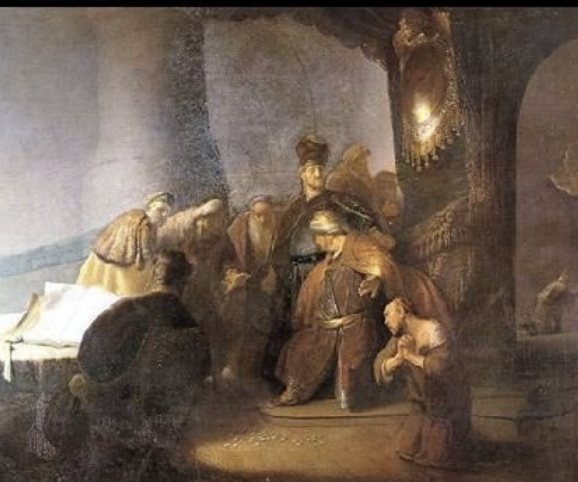
Judas returning the 30 Pieces of Silver
I am going to describe Rembrandt’s originality in somewhat different terms to the usual praise of his mastery of light or his broad brushwork which are admirable but not crucial. Rembrandt bought and studied no fewer than 30 Roman portraits. They were much sort after and therefore very expensive. He filled two books of studies of them. Kenneth Clark finds him lacking in taste in doing so because Roman work has been consistently disparaged by art historians since Winckelmann. This is a huge mistake in my view; half the artists of Europe use the three dimensional geometry found in Roman portraits as the form base of their work: Masaccio, Mantegna, Holbein, Rembrandt, Degas and Van Gogh to name but a few. Most use it as the method of suggesting the three dimensional nature of solid objects, Rembrandt went further and used it to define the space between his protagonists as well. By this means coupled with observation from live groups, he has a control over space relationships which is uniquely precise. It is the way in which he conveys drama or psychological relationships; his particular gift.
Normally artists use pespective to define space, and if you are constructing space this is the only way. But Rembrandt was observing space from tableaux vivent he set up for himself and his students to work from. The creation of the tableaux was an important part of his art. His student Hoogstraten tells us as much, yet the experts think its more exciting if artists imagine it all. Alas, artists never make so good a job of intimate space by construction as Rembrandt did from observation. It is another of his original insights that space needs to be observed. I am sure he would not have described it that way himself, consciousness of space perception is a recent 20th Century notion but Rembrandt was the the greatest practitioner. Giacometti introduced me to the importance of space, his obsession; but he did not use it with the psychological insight of Rembrandt. It is the most important artistic insight in my life-time. It has driven my approach to criticism.
Perspective is useless for depicting intimate space, just about OK for theatrical space. This is the foundation of Rembrandt’s genius, The experts continue to deny the existence of the tableaux now 40 years since I prove them by pointing out that Rembrandt not only drew them direct but on many occasions made drawings from their mirror image, that is a different view reversed of the same three dimensional group. See Rembrandt’s Adoration of the Shepherds. Of course these groups existed. This is another embarrassment for scholars who have filled library shelves with books on the iconography of Rembrandt and his school; where I see the differences of treatment largely as simply difference of physical points of view of the same group subject, student and master working together looking at the tableaux from individual viewpoints, they are primarily physical difference not differences of interpretation. The scholars’view that students worked from Rembrandt’s drawings is totally impracticable – Rembrandt himself never did it but scholars are determined that Rembrandt imagined and his students followed after – because Benesch told them so. All the evidence is with me, not with the scholars.
Rembrandt used his drawings to feel his way into a subject in a general way there are no preparatory drawings such as one finds in Renaissance masters. Rembrandt is capable of making over 20 versions of the Hagar story and then a painting which has almost no relation to the drawings. I would date all around 1637 the date he wrote on the etching-plate; the scholars refusing to take note of Rembrandt’s use of mirrors and chose to believe he returned to the same subject throughout his life! Rembrandt explicitly rejected as “worthless” anything that was not observed. All the evidence favours the fact that the group was assembled in 1637 and may have been present in the studio for several months perhaps in part even years as his students made big important painting from them. (link Hagar video)
In my explanation of the National Gallery’s version of The “Adoration of the Shepherds” a small painting of a large, varied group of humans, animals and architecture seen from a different point of view and reversed by the mirror but of the same group as posed for Rembrandt’s Munich painting of the same subject (see YouTube link). This is a proof as clear and beyond dispute as checkmate. Yet the experts take no notice, they continue their destruction as if all was as they have been told. Furthermore, their belief flies in the face of all the contemporary witnesses who tell us over and over again that “Rembrandt was taught by nature and by no other law”, or words to the same effect.
My work has been endorsed by quite a few scholars. Prof. Sir Ernst Gombrich insisted that it got published and his name appears on the original article in The Burlington Magazine (Feb 1977) as having helped me to formulate it. The maquettes from my exhibition at Imperial College were reviewed by Prof.Bryan Coles with the words “ some of which compel assent”…. “it would be a pity if scholarship did not profit from his imaginative researches” (see also the list of eminent supporters link) But alas, these proofs also make the scholars look foolish, so they ignore them.
I do not have to believe Rembrandt was a perfect human-being or a consistent artist in order to venerate him. One of the most endearing features of his work is his total acceptance of life as it happens. There is nothing of the hubris that led Michelangelo to destroy his preliminary studies or his misadventures. Rembrandt has left us an entirely unedited version of his production. I know of no other artist who went out of his way to show how anything imagined “was worthless in his eyes”. Most of his flying angels are drawn with a deliberate worthlessness. No worries about his inability to imagine the scene of Jupiter’s visit to Philemon and Baucis 8. He is practising what he preached – his valuation of truth above all – see also the etching of Diana, a truly hideous version of the virgin goddess from a young man out to make a point about truth.

Diana by Rembrandt, a provocative view of the virgin goddess
The ‘Unreliable’ Rembrandt
I agree with Gary Schwartz “the study of Rembrandt has much to gain from the serious consideration of the negative criticisms voiced by his contemporaries.” and they do not find Rembrandt at all reliable or consistent.” Benesch’s error is pure wish-fulfilment that has resonated with his heirs and followers.
By his study of the documents Schwartz brings into question many aspects of Rembrandt’s character that suggest his untrustworthiness. He was struck out of his sister’s will and his wife’s will, he was never asked to be godfather to a child, “he himself sabotaged his career” says Schwartz – I take all that on board. I think you will find below good reason to view Rembrandt’s behaviour as highly erratic.
Supreme self-confidence does not normally sit well on the shoulders of an artist. But Rembrandt’s confidence in his own judgement is the foundation of his ability to push art in the direction of truth above conventional beauty; it has earned him everlasting fame for very good reason but it caused no end of criticism in his life-time and again recently.
Von Sandrart tells us that Rembrandt “had no understanding of the importance of social rank “it is certain that had he been able to keep on good terms with everyone and look after his business properly” he would have made a fortune. Baldinucci writes that “not even the foremost monarch on earth could gain an audience but would be sent away until Rembrandt had finished his work”. The Prince of Orange had to wait fourteen years for the last of his Passion series. The painting arrived still wet and the Prince paid only half the asking price. The Sicilian nobleman for whom Rembrandt painted several portraits sent back two complaining that he had bought work from Italy’s most famous painters and never paid so high a price nor received work so ill completed (his portrait of Alexander the Great was sown together from four pieces of canvas).
Rembrandt’s dealings with commoners took a similar pattern. His quarrels with his first mistress and with Saskia’s family after her death show us a man who was lacking in diplomacy to say the least. There are stories of him painting the corpse of his dead monkey into a commissioned family portrait and keeping the painting himself rather than removing this nasty, unwanted addition.
Harsh Criticism
There are constant complaints from his contemporaries such as “he did not finish his paintings properly – it is rare to find in Rembrandt a well painted hand – his female nudes …etc. Rembrandt answered these criticisms with “a picture is finished when the artist has expressed his intentions in it”. It is this clarity about his intentions and their revolutionary nature that makes Rembrandt such an important example to artists. His female nudes are not idealised as was expected at that time. They were shockingly unglamorous and by no means always well done.
All this evidence needs airing. On occasion I think Schwartz has taken an over-negative view of the evidence. For instance he says of Rembrandt’s relations with his students “the few stories that have found their way into the sources are not heart-warming at all.” He also finds Rembrandt humourless and miserly. Houbraken tells stories which suggests quite the opposite to me: Rembrandt comes upon a scene where his students are eavesdropping on another student and his model locked together in the student’s room. He overhears him say “here we are naked like Adam and Eve in the Garden of Eden” at this point Rembrandt bangs on the door and shouts “Because you are aware of your nakedness you must come out of the garden” and then chased them down the stairs with his stick, I guess as theatre, because “they scarcely had time to dress as they fled”. On other occasions students painted coins on the floor in order to see him stoop to pick them up. This suggests to Schwartz that Rembrandt was over attached to his money. To me It confirms that he had a playful relationship with his students some of whom stayed with him for many years though he charged twice as much for an apprenticeship as his rivals. There are many references to Rembrandt’s generosity in lending objects from his collection to painters who needed them. Generosity again In paying over the odds for works by his contemporaries to boost their value and paying extravagantly for works of art generally; he was profligate as well as generous. When he had money he certainly threw it about. His great house proved much more than he could afford but that was as much bad luck as bad judgement; he lived through a severe recession in Holland caused by war with England. Fashions in art change. Rembrandt like many others found it difficult to adjust.
Rembrandt changed the course of art. He seemed so completely immune to criticism that it might help us to understand him better to take these aspects of his character into consideration. If scholars realised they were dealing with a man who exhibits many of the symptoms of Bipolar behaviour, they might treat him more kindly and abandon their efforts to normalise him. They want him to be consistent, he was not; and we cannot understand him unless we take his inconsistencies into account. Some were psychological in origin and some were physical. The difference between Rembrandt’s drawing direct from life and when he relied upon a dim reflection in a polished metal surface, or even worse when he relies on his imagination, is very obvious but at present overlooked by the experts. (for examples, see my ebook www.nigelkonstam.com)
These stories and complaints should surely alert us to the fact that Rembrandt, great painter as he is, was not an entirely reasonable human being. As Bernard Shaw noted – “The reasonable man adapts….All progress depends on the unreasonable man”
I am no psychologist I would like to hear what professionals think of this evidence. Rembrandt’s behaviour, his output, his charisma and his supreme self-confidence all seem to me to point to manic-depression. But there is a miraculous quality to his best drawing that is beyond compare. Those who know the genius of Stephen Wiltshire’s memory may have some idea of the level to which Rembrandt’s memory and manual dexterity supersedes all save Stephen. He seems capable of catching a passing event such as this flash of anger (3) as if there is a photo in his mind to which he can return many times after it has passed, to recapture it on paper. Stephen can spend a fortnight drawing a city-scape from the memory of a casual glance from a helicopter; Rembrandt may have had a tiny fraction of that magic.
There was a famous teacher who devised a method of improving visual memory, Lecocq de Boisbaudran. It produced some excellent results but has fallen into disuse perhaps because artists have lost sight of the need of even very short term memory between looking at the object and reproducing it on paper. Lecocq’s method was to remember a Holbein drawing and then reproduce it from memory.
The results were stunning because one cannot remember a Holbein without absorbing his pattern of form making. His heads are universally admired so it is little wonder that Le Coq’s students included Rodin, Fantin-Latour, Dalou and many others. An amusing recent experiment compared an ape’s visual memory with a human’s; the ape’s was incomparably the better. We have clearly lost something as we have climbed the evolutionary ladder.
I hope you have been persuaded that Rembrandt is not the inventor the experts imagine but an observer who responds more truly to that arc of experience which concerns us humans most. We must save Rembrandt from the experts before it is too late.
Blogs and videos at www.nigelkonstam.com
Practical Art History courses www.verrocchio.co.uk